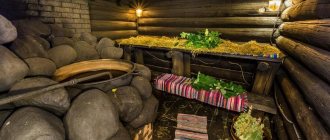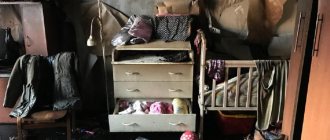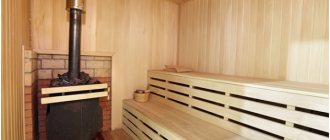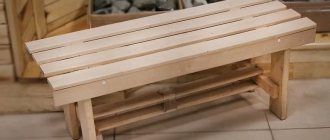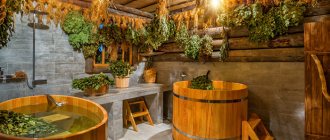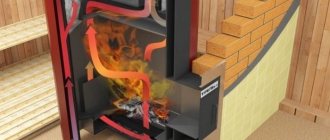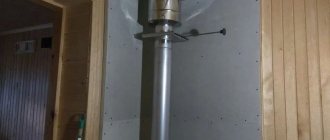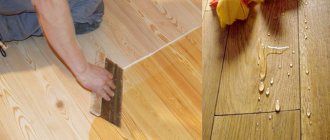High fire safety requirements for saunas and baths are due to the following factors:
- unsafe temperature conditions;
- structure made of wood or covered with it, resinous elements;
- ovens;
- compact space;
- ventilation;
- not all elements come into contact with water;
- presence of electrical wiring.
Examples of causes of fire:
- violation of rules for handling equipment;
- electric oven not turned off;
- insufficient protection between the wood stove and the walls, chimney and ceilings/roof.
Features of fires in the bathhouse:
- pyrolysis gas is released;
- a mixture for spontaneous combustion is formed;
- the effect of air suction with a flame explosion.
Fire safety standards for the construction of a bathhouse
Fire standards are taken from sections of GOSTs, compared with the classification of saunas/baths by flammability. Apply:
- by buildings:
- SNiP 31-05-2003 (SP 117.13330.2011) (clause 6.3.9), 2.09.04-87 (SP 44.13330.2011) (clauses 2.34, 2.35, 2.36);
SP 118.13330.2012 (SNiP 31-06-2009), 53.13330.2011, 54.13330.2016, 55.13330.2016 (SNiP 31-02-2001);
- general rules:
- SNiP 21-01-97 aka SP 112.13330.2011 – PB classes;
NPB 110-03, 88-2001;
- Federal Law 123 – technical regulations, fire resistance limits, fire safety classes;
- projects, planning, placement:
- SP 11.106-97, 4.13130, 60.13330 (SNiP 41-01-2003);
- equipment:
- SP 7.13130;
Rules for electrical installations;
- "Methodological recommendations for the design of baths...".
Baths are built only according to pre-agreed projects according to SP 11.106-97.
Bathhouse: functional fire hazard class
According to PB standards and clause 5.21 of SNiP 01/21/97, baths, saunas, health institutions, sports and training institutions without stands, and household facilities are assigned class F3.6.
PB of a free-standing bathhouse
Fire resistance level of the sauna building:
- fire resistance – not lower than III;
- for 20 places and less – IV – V.
Fire safety requirements for room parameters:
- steam room:
- volume – from 8 m³, but not more than 24 m³;
in height - not less than 1.9 m;
- up to 2 floors;
- separate exit;
- supply and exhaust ventilation;
- gap under the door – from 30 mm;
- compliance with the location in relation to neighboring buildings, from the fence to the bathhouse.
PB saunas inside the house
Safety for placing built-in saunas:
- in objects of I - III degrees of classes C0 and C1 the following are distinguished:
- fire-resistant barriers of type I with resistance limit REI-45;
type III covering elements, REI-45;
- in buildings of IV degree, C0 - C3 - with the indicated structures REI 60;
- a separate exit for evacuation, not combined with other passages;
- seats in the sauna steam room - up to 10 people.
According to fire safety standards, built-in dry baths (saunas) are prohibited in:
- basements (ground floors);
- adjacent (above and below) to objects where more than 100 people stay. or to the living rooms of neighboring apartments;
- in dormitory buildings;
- under the stands.
The restrictions do not apply to establishments put into operation before the adoption of these changes, and the infrared sauna also circumvents the prohibitions.
Distance from the house to the bathhouse according to fire safety
Fire regulations for placement:
- distance between house and bathhouse on one site:
- brick sauna with a non-combustible roof - 8 m from the same building, if the second building with a combustible roof - 10 m;
if the roof of a brick bathhouse is fire hazardous - 10 m;
- both buildings are made of wood - 10 m, if more than 1 floor - 15 m;
- to a neighboring house on a different site from the fence (distance to the border, but the total distance is as indicated above):
- without sewerage – 3 m;
with drainage, drain – 1 m;
- distance from the bathhouse to the bathhouse of the neighboring plot. Distance standards - 10 - 15 m (wooden) and 6 m (brick) - from table. 11 Federal Law 123 is outdated, therefore the rules of the previous paragraphs apply.
Fireproof materials
Fire resistance limits for sauna materials:
- degree – I – III;
- fire hazard of load-bearing elements – C0 and C1;
- fire resistance limit of materials EI-45, EI-60.
Fire safety methods and materials for saunas are usually structural:
- partitions – I, ceilings – III type of fire resistance. It is allowed to use plastic glass blocks;
- fire-retarding valves in ventilation;
- fireproof insulation for all heating elements, chimney: basalt, mineral wool;
- setback, fire gap - the distance between devices and walls;
- cuttings - filled/made indentations (with brick, vermiculite, etc.);
- aprons;
- cladding
Wooden bath structures can be protected with impregnations, but only with special (non-toxic) impregnations intended for objects of this type, preferably antiseptic (against rotting), OE group 1. Deep processing technology is recommended.
The compositions should be used only in certain places, since the OS minimizes the smell of natural wood, as well as for elements that are not in contact with the human body (not in the steam room, near stoves, remote places).
Electrical requirements
In steam rooms, the use of electric furnaces is common. The premises also have wiring for lighting fixtures. Requirements:
- compliance with the PUE;
- reliability of power supply:
- Category 2 – from 100 places;
Category 3 – up to 100 places;
- cable entries made of asbestos-cement pipes from 100 mm with a slope from the building;
- all cables are heat-resistant;
- switches in wet rooms are not allowed;
- wires for maximum room temperature;
- do not place input distribution units, switches under steam rooms, bathing rooms, or other wet places;
- lamps in wet and humid conditions are protected by heat-resistant glass and mesh;
- internal wiring:
- aluminum;
in steam rooms - copper with heat-resistant insulation;
- open, pipeless (attached with staples to the surface) with asbestos cord winding;
- protective grounding.
II. BASIC FIRE SAFETY REQUIREMENTS
3. The area adjacent to the sauna must be promptly cleared of flammable waste, garbage, containers, dry grass, etc. in containers (boxes), which are then transported to specially designated areas.
4. The area must have lighting sufficient to quickly find fire extinguishing equipment, water sources, stairs, and entrances to the building.
5. Roads, driveways, entrances and passages to the bath-sauna and water sources used for fire extinguishing, approaches to fire equipment must always be free, maintained in good condition, and in winter removed from snow and ice.
6. Fire-fighting systems and installations (fire automatic equipment, fire-fighting water supply) must be constantly maintained in good working order.
7. Bath-saunas with a capacity of less than 20 seats are allowed to be designed with IV-V degrees of fire resistance.
8. When remodeling premises or changing their functional purpose, the fire safety requirements of the current standards for this type of building must be observed.
9. Bath-saunas of small capacity should be separated from other premises by fireproof partitions and ceilings with a fire resistance limit of 0.754; Evacuation exits from these premises are not allowed to be combined with exits from other premises of the buildings.
10. The use of resinous wood for sauna cladding is not allowed.
11. The distance from the electric heater to the wall cladding of the steam room must be at least 20 cm.
12. A fireproof heat-insulating shield should be installed above the electric heater under the ceiling. The distance between the shield and the ceiling lining must be at least 5 cm.
13. The temperature in the sauna must be maintained automatically.
14. The sauna bath must be provided with natural supply and exhaust ventilation, which should also ensure effective ventilation of the steam room after use. The ventilation duct must be equipped with a fire-retarding valve. The steam room of the bath-sauna must be equipped with a perforated dry pipe leading into the vestibule, equipped with half-nuts for connecting mobile fire fighting equipment.
15. Heater stoves must only be factory-made, equipped with automatic equipment.
16. The electrical network must be made of copper wire, in heat-resistant insulation designed for the maximum permissible temperature in the sauna.
17. The heating elements must be connected to the electrical network outside the steam room.
18. After entering the electrical cable to the electrical panel, an RCD (residual current device) with an operating current of no higher than 30 mA must be installed.
19. A protective grounding should be provided in the sauna bath.
20. At least once a year it is necessary to measure the insulation resistance of the electrical network.
21. In the bath-sauna premises it is prohibited:
- operate the heater with a disconnected or faulty thermostat;
- leave the electric heater of the stove unattended;
- independently repair or replace any electrical equipment;
- use electric heating household appliances outside specially equipped places;
- Dry clothes on the fence of the stove or directly next to it;
- clean premises using flammable liquids and flammable liquids;
- carry out repair work using open fire;
- install blind bars on windows;
- use damaged sockets, switches, and other electrical installation products;
- use electric heating devices without stands made of non-combustible materials;
- leave unattended electrical appliances, televisions, radios, etc. connected to the network;
- use non-standard (homemade) electric heating devices, use uncalibrated fuse links or other homemade overload and short circuit protection devices.
22. At the end of the sauna operation, the person responsible for the fire safety condition is obliged to carry out a thorough fire safety inspection of the premises, eliminate any existing violations, and completely de-energize the electrical network using a general switch (switch).
How to protect a bathhouse from fire from the stove
Heating options for saunas:
- brick or metal wood stove;
- electric furnaces (electric heaters).
Wood-burning stove equipment according to SP 60.13330.2012 is permissible only for one-story bathhouses with seats for up to 25 people. Ways to protect a sauna from fire from the stove: cladding, casings, lining, offsets, cuts.
What are the dangers of stoves:
- dumping burning particles;
- release from the firebox and body, especially in case of emergency damage (hull burnout / masonry cracks):
- sparks;
flame;
- hard to detect cracks;
- heating of surrounding elements (floor, ceiling, walls) by the furnace body.
How to cover/cover a stove
Enhanced fire safety measures for heating equipment:
- screens for sauna stoves (casings):
- brick, metal;
corrugated roofing materials;
- plaster 25 mm on an iron mesh chain-link or on asbestos with a thickness of 8 - 10 mm;
- lining (cladding) is required when heating with a metal stove:
- the floor in front of the door is covered with a steel sheet of 50x70 cm. In a long line along the stove. Around there is a steel sheet on asbestos cardboard 150 mm larger than the dimensions of the body;
podium and apron: brick, concrete, ceramic (tiles), asbestos and iron;
- for walls: fire-retardant boards, mineral insulation with a metal base or brick;
- non-combustible floor - higher from the main one;
- fire distances from the stove (setback):
- to combustible floors without protection - from 210 mm (air or brick), with protection - from 100 mm;
to the walls - no less than 200 mm;
- from the ceiling at least 1200 mm, always with a fire-resistant sheet;
- fencing:
- there is a shield under the ceiling (5 cm from the surface);
cases (metal covers) against spilling of fuel, sparks, flames;
- cuttings for brick chimneys – from 500 mm.
Temperature for stoves according to NPB (can only be observed if shielded):
- +120°С for the body;
- +80°C for walls;
- below +50°C.
The standards are not always the same, so they are also guided by:
- manufacturer's instructions;
- engineering considerations;
- recommended materials.
The temperature in places where the stove comes into contact with flammable objects should not exceed +50°C.
How to secure a chimney pipe
Chimney fire protection:
- fencing:
- shielding of walls (metal sheet), one sandwich pipe is not enough;
passage box with backfill;
- interfloor divisions are mandatory;
- the brick pipe is coated with clay and whitened to visually detect cracks and soot;
- at least 380 mm to combustible structures (rafters, roof sheathing);
- chimney cutting:
- interfloor vertical mandatory: height from 70 cm, thickness from 12 cm, for temperatures from 100°C - 25 cm;
desirable horizontal (brickwork) for the attic;
- thermal insulation along the entire length;
- inspection hatches;
- you cannot connect 2 stoves simultaneously to one chimney pipe;
- regular cleaning and inspection.
Danger of chimneys:
- holes become clogged;
- risk of burnout, cracks;
- heating of surrounding elements;
- soot accumulation: a layer of 2 – 3 mm is fire hazardous.
PB requirements for the installation of electric furnaces
Standards on how to protect a bathhouse from fire when using an electric heater:
- power exactly according to the parameters of the sauna, but up to 15 kW;
- self-shutdown after 8 hours of operation;
- control unit in a dry place in front of the steam room;
- all cables are fireproof insulated;
- wiring to the control cabinet:
- copper;
in steel pipes in concrete floor preparation;
- potential equalization grid;
- the distance to the walls is up to 20 cm, under the ceiling above the device there is a heat-insulating shield with a distance to the casing of at least 5 cm.
- in automatic mode, the temperature in the steam room is up to +110°C, automatic shutdown at +130°C.
Provide proper ventilation
This is important so as not to get burned, so that it is not too stuffy or too cold. If you have an ordinary Russian bathhouse without many separate rooms, then all you need is a door, a small window, good stove draft and mandatory ventilation after everyone has washed.
The bottom of window openings in the main rooms of the bathhouse must be at a height of at least 1.2 m from the level of the finished floor, and in showers and bathtubs - at least 1.5 m.
If you choose the right hood in the bathhouse, then choose the exhaust type of forced ventilation. A fan in the exhaust vent removes polluted air, creating a vacuum inside, forcing clean air from the street to fill the vacated volume, entering the supply vent.
Fire extinguishing agents in saunas and baths
For private steam rooms there are no requirements for alarms or extinguishing installations. But, if this is a public, commercial building, then it is necessary to protect the bathhouse from fire with extinguishing and notification systems.
Which fire extinguisher is better
Features of fire extinguishers:
- – effective, but there is a risk of carbon dioxide poisoning (requires special protection), do not wet, cold burns are possible;
- , ORP - ends quickly, with a weak stream;
- – universal, create a non-flammable layer of powder;
- OVE - effective, harmless.
{banner_downtext} For baths, air-emulsion fire extinguishers are recommended, preferably from 8 liters, and powder ones, especially for objects with an electric heater, since the extinguishing agent does not conduct electricity.
Fire extinguishing systems
Steam rooms in public and commercial establishments must be equipped with automatic deluge fire extinguishing systems:
- dry pipe;
- source - internal water supply;
- automatic and manual start simultaneously;
- remote control, valve in a separate room nearby or in front of the entrance.
Sometimes sprinklers are installed, but with activation from +125°C, and there is logic in this, since the need to open doors, leading to a flame explosion, is reduced. Foam and water installations (drenchers, sprinklers, expansion valves) are standard for saunas.
Do you need a fire alarm in a bathhouse?
The instructions on safety measures do not contain requirements for the presence of fire alarms in private baths, but the equipment is mandatory for public and commercial establishments.
According to NPB 110-03, a sauna is a building for public, domestic purposes and must be equipped with automatic alarms, except for wet rooms (steam rooms, showers, sinks).
Sensors, detectors
In locker rooms, dressing rooms, and auxiliary parts (not wet), heat fire detectors and smoke detectors must be installed. In wet rooms (steam rooms), sensors are installed less frequently or are not used, but they are not prohibited. There are special devices for baths, for example, IP 105-1 G “Sauna-150” with activation at +110°C.
III. ACTIONS IN CASE OF FIRE
23. If burning, smoke or a burning smell is detected, the first person to notice is obliged to immediately turn off the power, report the incident to the fire department by phone 01, the shift manager of the traffic police and the work manager (foreman) by phone or radio station (walkie-talkie), indicating the location of the object where the fire started, what is burning and your name.
24. Evacuate people, material assets and, while maintaining personal safety, try to extinguish the fire using improvised means, a fire extinguisher located in the room or the fire equipment of a residential town.
25. In the event of a threat to people’s lives, immediately organize their rescue, using available forces and means for this.
26. When extinguishing a fire, if it is impossible to turn off the power, you must remember that extinguishing electrical wiring and electrical equipment is allowed only with carbon dioxide or powder fire extinguishers.
27. Before the arrival of the fire department, general management of fire extinguishing (taking into account the specific features of the facility) is carried out by the work manager (the person replacing him), he is obliged to:
- duplicate the message about the occurrence of a fire to the fire department and notify senior management;
- check the activation of automatic fire protection systems (notifying people about a fire, fire extinguishing, smoke protection);
- stop all work (if this is permissible according to the production process) except for work related to fire extinguishing measures;
- ensure the protection of people, in compliance with safety rules, taking part in fire extinguishing, from possible electric shock, poisoning by combustion products and burns;
- take measures to cool adjacent technological equipment and building structures with water (using improvised means) from exposure to high temperatures, without stopping fire extinguishing.
28. Upon arrival of the fire department, the work manager (or his replacement) is obliged to:
- organize a meeting with the fire department and provide assistance in choosing the shortest route to the fire;
- inform the fire extinguishing manager about the design and technological features of the facility, adjacent buildings and structures, the quantity and fire hazard properties of stored and used substances, materials, products and other information necessary for the successful extinguishing of the fire, as well as organize the involvement of forces and resources of the facility in carrying out the necessary measures related to fire extinguishing and preventing its development.
document
Didn't find the document you need? Order its development!
Development of custom labor protection documentation
Make your steam room completely safe
The best option for low ceilings is heat-resistant LED strip for sauna or flat lamps.
It is better not to use massive shades and lamps, because a drop of sweat getting inside can easily lead to a short circuit, and drops from a broom get anywhere. If you are steaming in the dark, screw in at least one “smart light bulb” with a battery. If there is no voltage in the network, it can be turned on as a flashlight.
Make sure that the door closes and opens easily (outward only) and moves freely on its hinges.
It definitely does not need upholstery, the handle is exclusively wooden, even a small child should be able to open it. Also leave a gap at the bottom for constant air circulation. Translucent doors with heat-resistant glass are best suited to let in maximum light. But keep in mind that the thickness of such a door must be at least 8 mm; it is made of tempered glass. It won’t close like a lock, and if someone in the steam room “overdoes it,” others will notice it through the glass.
What to remember
- Build a sauna with special LOGICPIR Sauna slabs.
- Think about proper planning.
- Provide proper ventilation.
- Protect yourself from potentially dangerous elements.
- Think over to the smallest detail the central place of the bathhouse - the steam room.
Operation phase
When all construction aspects are completed, you can enjoy the result. To make it long and safe, follow 6 simple rules:
- Do not use gasoline or flammable liquids for ignition. Choose newspapers and dry firewood.
- Do not bring it to the maximum temperature - 110 ° C, otherwise the wood will begin to smolder.
- Clean the chimney regularly to remove soot.
- Monitor the condition of the masonry stove chimney and wiring of the electric stove; if cracks or malfunctions are detected, do not delay repairs.
- Do not leave the sauna firebox unattended.
- Do not drink alcohol, do not smoke, and do not dry clothes over the stove.
A bonus for those who read to the end is a clear infographic to make it easy to remember.
“Stove fires” are divided into two groups
1. The cause of the fire may be a violation of the rules for constructing the stove. For example, there is insufficient distance between the stove chimney and the wooden floor structures of the house. This also includes the absence of a flood sheet, as a result of which the floor catches fire due to fallen coals.
2. Another problem is violation of fire safety rules when operating the stove.
Also, lighting stoves with gasoline, kerosene and other flammable liquids, as well as overheating stoves, often ends in fire. In addition, you cannot heat stoves with open doors, dry clothes, firewood and other materials on them, and the surfaces of heating devices and chimneys must be systematically cleaned of dust and whitened. Cracks and problems found in the stove must be repaired in a timely manner in order to prepare the stove for the new heating season.
Preventive measures
To increase the fire resistance of wood, it is treated with special impregnations that prevent combustion - fire retardants. The principle of operation of such products is either the melting of special substances included in their composition (salts of boric, phosphoric or silicic acids), or the release of gases that impede the combustion process (ammonia, sulfur dioxide). In the first case, a film shell is formed on the surface of the wood, limiting the access of oxygen. The result is an increase in ignition temperature. In the second case, non-flammable gases released during the decomposition of salts displace oxygen from the surface, interfering with combustion and slowing down the spread of the flame.
Depending on the composition, fire-fighting agents either prevent the spread of flame (group II of impregnations, the purpose is to ensure that wood is difficult to ignite), or provide comprehensive protection (group I - making the material difficult to burn). At the same time, the actual purpose of treatment with fire retardant compounds is not fire protection as such (it is clear that once a fire has started, impregnations cannot stop it). But they will give people time - because sometimes even 20-30 minutes are absolutely necessary in order to have time to take some action or simply leave the building.
Products applied to the surface require regular updating at certain intervals. The so-called deep impregnation, which is produced in an autoclave using the “vacuum-pressure-vacuum” technology, is more durable. It provides fire and bioprotection for the entire life of the structure. Wood after such treatment becomes difficult to burn (in the flame it does not burn, but smolders, and after the source of fire is removed, the smoldering stops).
The vast majority of products on the market today are combined, they are designed to solve not only fire protection, but also bioprotective problems, as well as issues of climate resistance.
Text: Vladimir Breus
Use special foil insulation
LOGICPIR PIR panels for baths are one of the thinnest insulation in the TECHNONICOL line of thermal insulation materials with a uniquely low thermal conductivity of 0.022.
Why is it important:
You will save space when installing a thermal circuit on the walls and ceiling.
The thermal circuit is a sealed box made of low thermal conductivity materials, on which the internal climate of any room depends. It is important to eliminate gaps in the insulation along the entire perimeter, otherwise a freezing wind will blow in from somewhere.
You will also save money.
Panels consume half as much compared to classic insulating materials. The foil layer in the structure simultaneously works both as a heat reflector and as a vapor barrier.
Your bathhouse will not rot, burn, or change its geometry over time.
LOGICPIR will last more than 50 years, and due to the low coefficient of water absorption, they are not susceptible to the destructive effects of water, mold, fungi, and rotting in conditions of high humidity.
During a fire, the outer layer of the slab is charred, forming a porous carbon matrix and thereby preventing the spread of fire. During the combustion process and in general under any operating conditions, the material does not emit any harmful substances for humans, which is confirmed by international certificates and the conclusion of the National Medical Research Center for Children's Health of the Russian Ministry of Health.
You can build a bathhouse anywhere.
With the special properties of LOGICPIR, it can be organized not only in a specially erected building, but also in an existing structure of suitable dimensions and configuration. The main thing is a flat and solid base. It can be a brick wall, reinforced concrete, aerated concrete or even a wooden beam.
For example, look at what a cool brick bathhouse one of TECHNONICOL’s clients built: youtube.com
You will save your nerves during installation.
The slabs are mounted to load-bearing walls and ceilings with offset end joints using the adhesive method using LOGICPIR adhesive foam. The slabs have ideal geometry, weight up to 500 g and a special L-edge at the joints, so they connect easily and smoothly.
